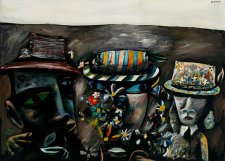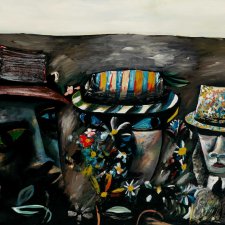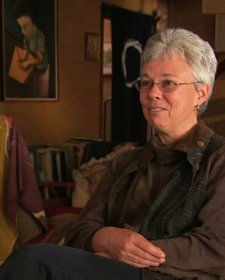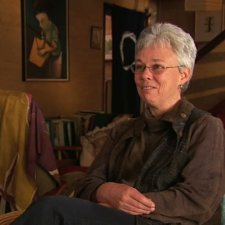Artist Charles Blackman OBE is perhaps best known for his series of paintings, prints and drawings incorporating characters and motifs from Alice in Wonderland. The figure of Alice was inspired by his wife, poet, writer and philanthropist Barbara Blackman AO (1928–2024). Just 15 when the ABC Weekly published one of her poems, Barbara became a member of Brisbane’s literary circle, joining the Barjai writers’ collective where she met the poet Judith Wright (1915–2000), who she is depicted with here. Wright had been experiencing hearing loss since her midtwenties, while Barbara had begun to lose her sight and was declared blind by the age of 22. Barbara later wrote: ‘She of the faraway voice and I of the faraway face did not find our lacks obstructive to the deepening roots of friendship.’ This double portrait dates from a period in Charles Blackman’s career when he had to economise on materials, and is executed in thin layers of oil paint, leaving the paper bare on the faces and skin. Barbara, in profile at the right-hand side of the composition, recalled that the hat she is shown wearing belonged to Wright. Her hand is spread protectively over her friend’s ear.
Gift of Joanna McNiven 2018. Donated through the Australian Government's Cultural Gifts Program.
© Charles Blackman/Copyright Agency, 2024
The portrait shows Judith Wright; poet, literary critic, editor, and fiction writer, with her friend Barbara Blackman; poet, writer, and philanthropist. The portrait is oriented horizontally, and measures approximately 115cm tall by 150cm wide including its unusual 10 cm frame. This is a complex work of bright colours, unusual shapes and bold textures
The wooden frame is like a series of concentric frames within frames, of varying widths and colours, painted to resemble different metals. On the outermost edge of the frame antique gold-leaf that has darkened and rubbed off in patches. Inside this, a wide band, painted green like the patina on weathered copper. The next band is narrower, the distressed, gold-leaf pattern is repeated. The band of frame closest to the painting is very thin and gleams pink like polished copper.
The background of the portrait is sky-blue. Judith and Barbara’s heads and torsos fill most of the space. The women’s faces are in profile, Judith on the left, Barbara on the right. The friends are connected by their gaze as they look at each other, their arms which reach across, and their upper bodies that seem to merge towards the bottom of the portrait.
The figures are not ‘life like’. Judith and Barbara’s silhouetted profiles are simplified and exaggerated in an almost cartoon like way. This simplicity, the defined line between their forms, together with the blue background gives the women the quality of collage paper cut-outs.
A limited colour palette of blue, red, yellow, white, and black has been chosen, and is blended in places to create green, purple, lighter and darker shades., Paint has been applied unevenly, with some thick streaks of colour, some areas washed with diluted colour, and other patches of the brown paper left bare.
Judith is slightly shorter. Her face turns towards her friend. Judith’s silhouette is simplified and geometric. A tall rectangle with triangular nose jutting out. She has a cropped red fringe, her eye, which slants down at the outer edge and seems to look up towards her friend, is a red outline and smudges of blue on the eyelids and iris. Judith’s cheek is a pink blur and the rest of her skin is the warm beige of the paper. Her cheek has been accentuated by a patch of translucent white. Judith’s lips have a purple-grey hue, and turn down, following the same angle as her eye. The rest of her hair - in blue, green, and red - falls straight down, ending in a blunt line level with her chin. Her hair is irregular vertical dashes, except at the ends, which are round dabs. Barbara’s large hand protectively cups the back of Judith’s head with her splayed fingers.
Judith’s torso faces forward. She is wearing a V-neck, sleeveless garment in blue-grey, on it, thick brush strokes roughly repeat it’s shape getting smaller and smaller. Judith’s left hand is emerging to clasp Barbara’s left shoulder.
Between the two figures the women seem to merge; at Judith’s forehead and Barbara’s hat brim; where Barbara’s arm extends out and across to her friend, and at the bottom where their bodies blend together, shoulder to breast. Blue space between them is emphasised by darker shading around the women’s profiles.
Barbara Blackman wears a hat with a low crown and wide brim, it casts a shadow over her brow. Barbara’s hair falls straight then flicks out slightly where it ends in line with her bottom lip. The shape of her hair is outlined in feathery black- blue brush strokes and filled in with soft, vertical smudges of deep-blue, rust-red, pale-blue and yellow.
The women are both in profile, Barbara’s head is wider at her forehead than her chin. Her broad nose extends down in a vertical line from her hat brim, her chin receding. Her eye, which meets Judith’s, has its upper eyelid delineated in black; a dark black and blue iris, a thick blue smudge for the lower lid. Her skin is a faint white, over the raw paper and there is a tinge of pink on her cheek. Her lips are two lines of rich red that turn up gently at the edge.
Barbara wears a light grey, round-necked, long sleeved garment. Her body turns towards Judith as the friends embrace.
Audio description written by Lucie Shawcross and voiced by Emma Bedford
Charles Blackman OBE (age 28 in 1956)
Judith Wright (age 41 in 1956)
Barbara Blackman AO (age 28 in 1956)
Joanna McNiven (1 portrait)



On one level The Companion talks about the most famous and frontline Australians, but on another it tells us about ourselves.



Dr. Sarah Engledow explores the context surrounding Charles Blackman's portrait of Judith Wright, Jack McKinney and their daughter Meredith.



Meredith McKinney, subject of Charles Blackman's 'The Family', recounts memories from her childhood and the creation of the portrait.